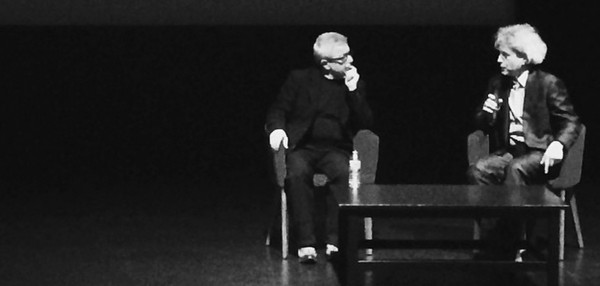Daniel Libeskind, in conversation with Professor Stephen Fai
Speaking poignantly the night before the 70th anniversary of the liberation of Auschwitz, Polish-born and New York-based acclaimed architect Daniel Libeskind presented a carefully curated selection of his work during the Azrieli School of Architecture + Urbanism’s fifth Forum Lecture event, this past Monday.
With a focus on projects related to the memory of the lives of those affected by the atrocities of the Holocaust, Libeskind began his talk by asking rhetorically “What is a monument?” His answer would frame the rest of the evening when he stated that it was to act as a memory of evil but also to give a sense of hope. This dichotomy – of evil and of hope, of the past and of the future – would then act as the theme for the multiple museums and memorials presented throughout the lecture, and which have been designed as monuments to the victims of the war.
The first project to be presented was Libeskind’s design for the Felix Nussbaum Museum, situated in Osnabrück, Germany, in a project he referred to as a “Museum without Exit.” The museum, which was built to display the work of Jewish painter, and Holocaust victim Felix Nussbaum, was designed to give a sense of no escape – a reality for many of those sent to the death camps – and was informed by the architect’s education not through archival research, but rather through “looking into the eyes of survivors.”
Initially referring the project as ‘26/284’, the faceless number given to Nussbaum by the Nazis, Libeskind detailed the three angular volumes which comprise the museum as symbolically representing three stages in the painter’s life: before the war, during the war, and the future (which contains paintings attributed to Nussbaum after his death). Each with its own material palette, the forms intersect in almost violent ways and give a sense of the fractured, non-linear life story of one of the millions of lives lost.
Libeskind next spoke to his intentions for the Jewish Museum Berlin, one of his best-known works, and explained that the project had initially been designed when the Berlin Wall was still standing – referring to a line which seemed to divide the museum in plan – and that it is likewise in plan that the folded Star of David can be identified.
This use of the line, and the oblique angle, would ultimately act as the two most prominent architectural and metaphorical devices used in the design of the museum. In one space, for example, there is a seemingly dead-ended corridor with an impossible angle to inhabit. It is then lit solely by a glow of reflected light, as if coming through a crack in the building’s façade. This architectural moment was inspired through a survivor’s story when she explained that even during her times of immeasurable strife, there was always, “a crack of light… and I held onto that white line.”
Libeskind continued, stating that without hope we could never build a museum about the Holocaust; for without the faith that the future can be different from the past, we could not face the horrors that have taken place. This is symbolized through the angular planes, representing an unstable territory, but which are then pierced with linear openings of light, acting as a graphic representation of a folded Star of David.
Other projects discussed during the evening included the Danish Jewish Museum, The Ohio State Holocaust Memorial, and Dresden’s Military History Museum, for which Libeskind explained, “It is important not to be nostalgic about history or see it just as one thing,” in reference to the double experience of the building.
Libeskind later concluded the evening by presenting the designs for the National Holocaust Monument, to be built adjacent to the War Museum at LeBreton Flats, and coordinated by the NCC.
First referring to the overall composition of the various triangular forms again resembling a Star of David, a continual motif in the architect’s work, Libeskind stated that the meaning of the form for him was found in a line from The Diary of Anne Frank, when she questioned, “Why us? Why the star?”
Speaking openly and personally throughout the night about his own family’s experiences during the war, Libeskind then showed a diagram of the various triangles that had been used to identify the many groups of people who were systematically persecuted by the Nazis, and referred to this use of geometry as the triangulation of evil. However, when these forms are overlaid, the Star of both suffering and hope is formed.
The monument itself, for which Libeskind and his team won the international design competition, was described as a visceral experience; a space open to orientation and interpretation, and one where you will never actually see the Star in its entirety. It will be composed of a series of spaces – some open, some enclosed, some slabs of concrete, other metal meshes – and where the idea of individual experiences is most significant.
Ultimately however, Libeskind, who has spent time in Toronto, stated that the monument was suppose to make us not only remember the irretrievable past, but also hope for the future, and to remind us of how fortunate we are to live in a country such as Canada. It will, as such, act as a memory of the horrors of the past, but also as a monument of hope for the future.

